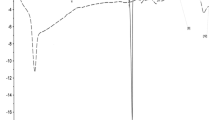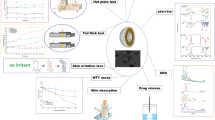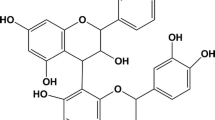Abstract
The present study used differential scanning calorimetry, thermogravimetric analysis, and UV spectrometry to examine: i) the encapsulation of an organic UV filter 1-(4-methoxyphenyl)-3-(4- tert-butylphenyl)propane-1,3-dione (avobenzone) within modified dextrin and ii) the characteristics of these inclusion complexes (MDA). The properties of avobenzone emulsions with and without encapsulation in modified dextrin, the in vitro UV protection factor, dissolution and release, and the skin penetrability of avobenzone were also examined. The presence of inclusion complexes significantly decreased the tendency of the UV filter to penetrate the skin. In addition, such inclusion complexes should effectively prevent skin damage from radiation extending from the UVA to the UVC.
Similar content being viewed by others
References
Anselmi, C., Centini, M., Rossi, C., Ricci, M., Rastrelli, A., Andreassi, M., Buonocore, A., & La Rosa, C. (2002). New microencapsulated sunscreens: Technology and comparative evaluation. International Journal of Pharmaceutics, 242, 207–211. DOI: 10.1016/s0378–5173(02)00159-x.
Chatelain, E., & Gabard, B. (2001). Photostabilization of butyl methoxydibenzoylmethane (Avobenzone) and ethyl-hexyl methoxycinnamate by bis-ethylhexyloxyphenol meth-oxyphenyl triazine (Tinosorb S), a new UV broadband filter. Photochemistry and Photobiology, 74, 401–406. DOI: 10.1562/0031–8655(2001)0740401pobmaa2.0.co2.
Chatelain, E., Gabard, B., & Surber, C. (2003). Skin penetration and sun protection factor of five UV filters: Effect of the vehicle. Skin Pharmacology and Applied Physiology, 16, 28–35. DOI: 10.1159/000068291.
COLIPA (2007). Guideline for the colorimetric determination of a skin color typing and prediction of the minimal erythemal dose (MED) without UV exposure. Brussels, Belgium: COLIPA.
Damiani, E., Greci, L., Parsons, R., & Knowland, J. (1999). Nitroxide radicals protect DNA from damage when illuminated in vitro in the presence of dibenzoylmethane and a common sunscreen ingredient. Free Radical Biology and Medicine, 26, 809–816. DOI: 10.1016/s0891–5849(98)00292–5.
Diffey, B. L., & Robson, J. (1989). A new substrate to measure sunscreen protection factors throughout the ultraviolet spectrum. Journal of the Society of Cosmetic Chemists, 40, 127–133.
Dissanayake, N. S., Greenoak, G. E., & Mason, R. S. (1993). Effects of ultraviolet irradiation on human skin-derived epidermal cells in vitro. Journal of Cellular Physiology, 157, 119–127. DOI: 10.1002/jcp.1041570116.
Garoli, D., Pelizzo, M. G., Bernardini, B., Nicolosi, P., & Alaibac, M. (2008). Sunscreen tests: Correspondence between in vitro data and values reported by the manufacturers. Journal of Dermatological Science, 52, 193–204. DOI: 10.1016/j.jdermsci.2008.06.010.
Hanson, K. M., Gratton, E., & Bardeen, C. J. (2006). Sunscreen enhancement of UV-induced reactive oxygen species in the skin. Free Radical Biology and Medicine, 41, 1205–1212. DOI: 10.1016/j.freeradbiomed.2006.06.011.
Hayden, C. G. J., Cross, S. E., Anderson, C., Saunders, N. A., & Roberts, M. S. (2005). Sunscreen penetration of human skin and related keratinocyte toxicity after topical application. Skin Pharmacology and Physiology, 18, 170–174. DOI: 10.1159/000085861.
Kockler, J., Oelgemoller, M., Robertson, S., & Glass, B. D. (2012). Photostability of sunscreens. Journal of Photochemistry and Photobiology C, 13, 91–110. DOI: 10.1016/j. jphotochemrev.2011.12.001.
Lin, L. H., & Chou, Y. S. (2010). Surface activity and emulsification properties of hydrophobically modified dextrins. Colloids and Surfaces A, 364, 55–60. DOI: 10.1016/j.colsurfa. 2010.04.033.
Mestres, J. P., Duracher, L., Baux, C., Vian, L., & Marti-Mestres, G. (2010). Benzophenone-3 entrapped in solid lipid microspheres: Formulation and in vitro skin evaluation. International Journal of Pharmaceutics, 400, 1–7. DOI: 10.1016/j.ijpharm.2010.07.028.
Montenegro, L., Carbone, C., & Puglisi, G. (2011). Vehicle effects on in vitro release and skin permeation of octylmethoxycinnamate from microemulsions. International Journal of Pharmaceutics, 405, 162–168. DOI: 10.1016/j. ijpharm.2010.11.036.
Nohynek, G. J., & Schaefer, H. (2001). Benefit and risk of organic ultraviolet filters. Regulatory Toxicology and Pharmacology, 33, 285–299. DOI: 10.1006/rtph.2001.1476.
Olvera-Martinez, B. I., Cazares-Delgadillo, J., Calderilla-Fajardo, S. B., Villalobos-Garcia, R., Ganem-Quintanar, A., & Quintanar-Guerrero, D. (2005). Preparation of polymeric nanocapsules containing octyl methoxycinnamate by the emulsification-diffusion technique: Penetration across the stratum corneum. Journal of Pharmaceutical Sciences, 94, 1552–1559. DOI: 10.1002/jps.20352.
Patel, M., Jain, S. K., Yadav, A. K., Gogna, D., & Agrawal, G. P. (2006). Preparation and characterization of oxybenzone-loaded gelatin microspheres for enhancement of sunscreening efficacy. Drug Delivery, 13, 323–330. DOI: 10.1080/1071754 0500398175.
Pathak, M. A. (1991). Ultraviolet radiation and the development of non-melanoma and melanoma skin cancer: Clinical and experimental evidence. Skin Pharmacology and Physiology, 4, 85–94. DOI: 10.1159/000210987.
Perugini, P., Simeoni, S., Scalia, S., Genta, I., Modena, T., Conti, B., & Pavanetto, F. (2002). Effect of nanoparticles encapsulation on the photostability of the sunscreen agent, 2-ethylhexyl-p-methoxycinnamate. International Journal of Pharmaceutics, 246, 37–45. DOI: 10.1016/s0378–5173(02)00 356–3.
Reece, B. T., Deeds, D., & Rozen, M. (1992). An in vitro method for screening sunscreen formulations for sun protection factor using a full-thickness skin model. Journal of the Society of Cosmetic Chemists, 43, 307–312.
Roscher, N. M., Lindemann, M. K. O., Kong, S. B., Cho, C. G., & Jiang, P. (1994). Photodecomposition of several compounds commonly used as sunscreen agents. Journal of Photochemistry and Photobiology A, 80, 417–421. DOI: 10.1016/1010–6030(94)01043–9.
Sadick, N. S., Karcher, C., & Palmisano, L. (2009). Cosmetic dermatology of the aging face. Clinics in Dermatology, 27, S3–S12. DOI: 10.1016/j.clindermatol.2008.12.003.
Scalia, S., Simeoni, S., Barbieri, A., & Sostero, S. (2002). Influence of hydroxypropyl-β-cyclodextrin on photo-induced free radical production by the sunscreen agent, butyl-methoxydibenzoylmethane. Journal of Pharmacy and Pharmacology, 54, 1553–1558. DOI: 10.1211/002235702207.
Scalia, S., Coppi, G., & Iannuccelli, V. (2011). Microencapsulation of a cyclodextrin complex of the UV filter, butyl methoxydibenzoylmethane: In vivo skin penetration studies. Journal of Pharmaceutical and Biomedical Analysis, 54, 345–350. DOI: 10.1016/j.jpba.2010.09.018.
Schlumpf, M., Schmid, P., Durrer, S., Conscience, M., Maerkel, K., Henseler, M., Gruetter, M., Herzog, I., Reolon, S., Ceccatelli, R., Faass, O., Stutz, E., Jarry, H., Wuttke, W., & Lichtensteiger, W. (2004). Endocrine activity and developmental toxicity of cosmetic UV filters: An update. Toxicology, 205, 113–122. DOI: 10.1016/j.tox.2004.06.043.
Shah, V. P., Elkins, J., Lam, S. Y., & Skelly, J. P. (1989). Determination of in vitro drug release from hydrocortisone creams. International Journal of Pharmaceutics, 53, 53–59. DOI: 10.1016/0378–5173(89)90361-x.
Springsteen, A., Yurek, R., Frazier, M., & Carr, K. F. (1999). In vitro measurement of sun protection factor of sunscreens by diffusive transmittance. Analytica Chimica Acta, 380, 155–164. DOI: 10.1016/s0003–2670(98)00577–7.
Tarras-Wahlberg, N., Stenhagen, G., Larko, O., Rosen, A., Wennberg, A. M., & Wennerstrom, O. (1999). Changes in ultraviolet absorption of sunscreens after ultraviolet irradiation. Journal of Investigative Dermatology, 113, 547–553. DOI: 10.1046/j.1523–1747.1999.00721.x.
Treffel, P., & Gabard, B. (1996). Skin penetration and sun protection factor of ultra-violet filters from two vehicles. Pharmaceutical Research, 13, 770–774. DOI: 10.1023/a:10160120 19483.
Wang, H. R., & Chen, K. M. (2006). Preparation and surface active properties of biodegradable dextrin derivative surfactants. Colloids and Surfaces A, 281, 190–193. DOI: 10.1016/j.colsurfa.2006.02.039.
Wang, S. Q., Stanfield, J. W., & Osterwalder, U. (2008). In vitro assessments of UVA protection by popular sunscreens available in the United States. Journal of the American Academy of Dermatology, 59, 934–942. DOI: 10.1016/j.jaad.2008.07.043.
World Health Organization (2010). Ultraviolet radiation and the INTERSUN Programme. Retrieved February, 2010, from http://www.who.int/uv/faq/skincancer/en/index1.html
Wu, H. L., Ramachandran, C., Weiner, N. D., & Roessler, B. J. (2001). Topical transport of hydrophilic compounds using water-in-oil nanoemulsions. International Journal of Pharmaceutics, 220, 63–75. DOI: 10.1016/s0378–5173(01)00671–8.
Yang, J., Wiley, C. J., Godwin, D. A., & Felton, L. A. (2008). Influence of hydroxypropyl-β-cyclodextrin on transdermal penetration and photostability of avobenzone. European Journal of Pharmaceutics and Biopharmaceutics, 69, 605–612. DOI: 10.1016/j.ejpb.2007.12.015.
Author information
Authors and Affiliations
Corresponding author
Rights and permissions
About this article
Cite this article
Li, CC., Lin, LH., Lee, HT. et al. Avobenzone encapsulated in modified dextrin for improved UV protection and reduced skin penetration. Chem. Pap. 70, 840–847 (2016). https://doi.org/10.1515/chempap-2016-0021
Received:
Revised:
Accepted:
Published:
Issue Date:
DOI: https://doi.org/10.1515/chempap-2016-0021




